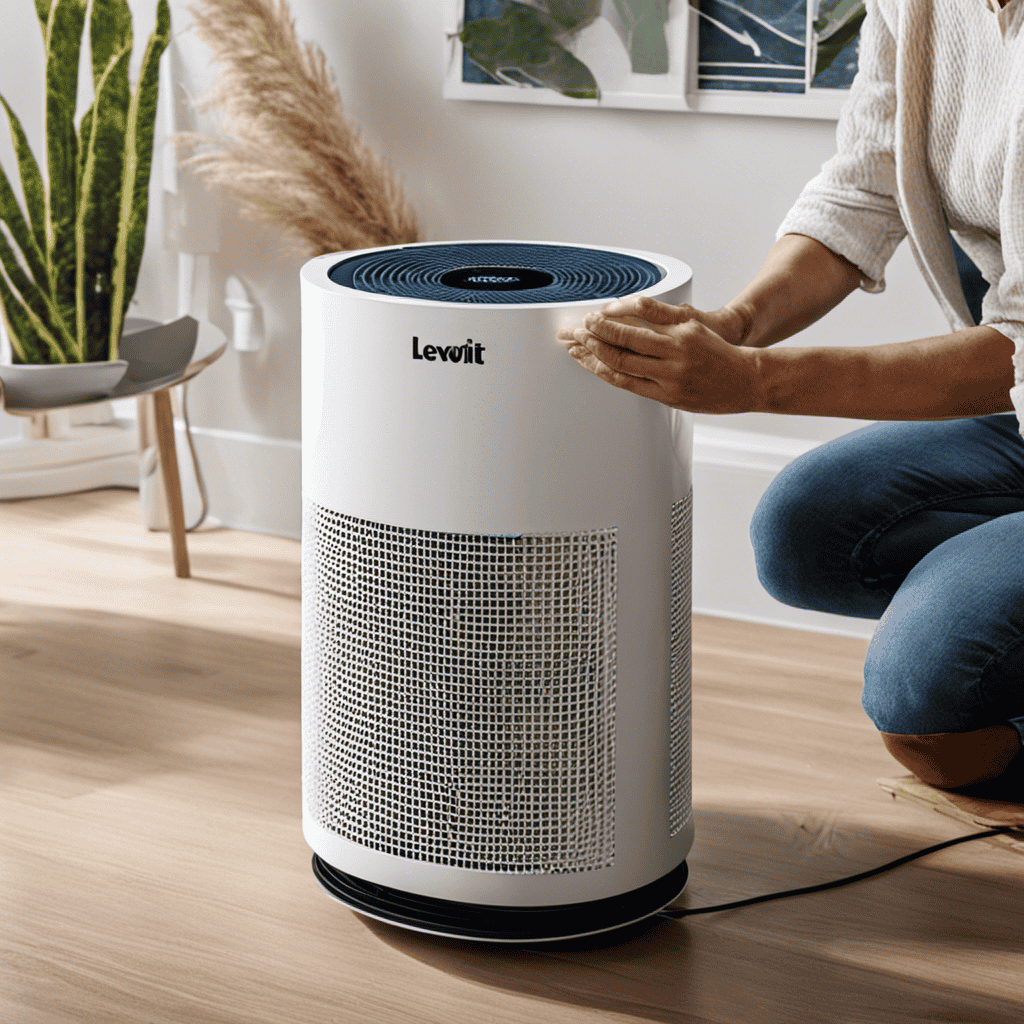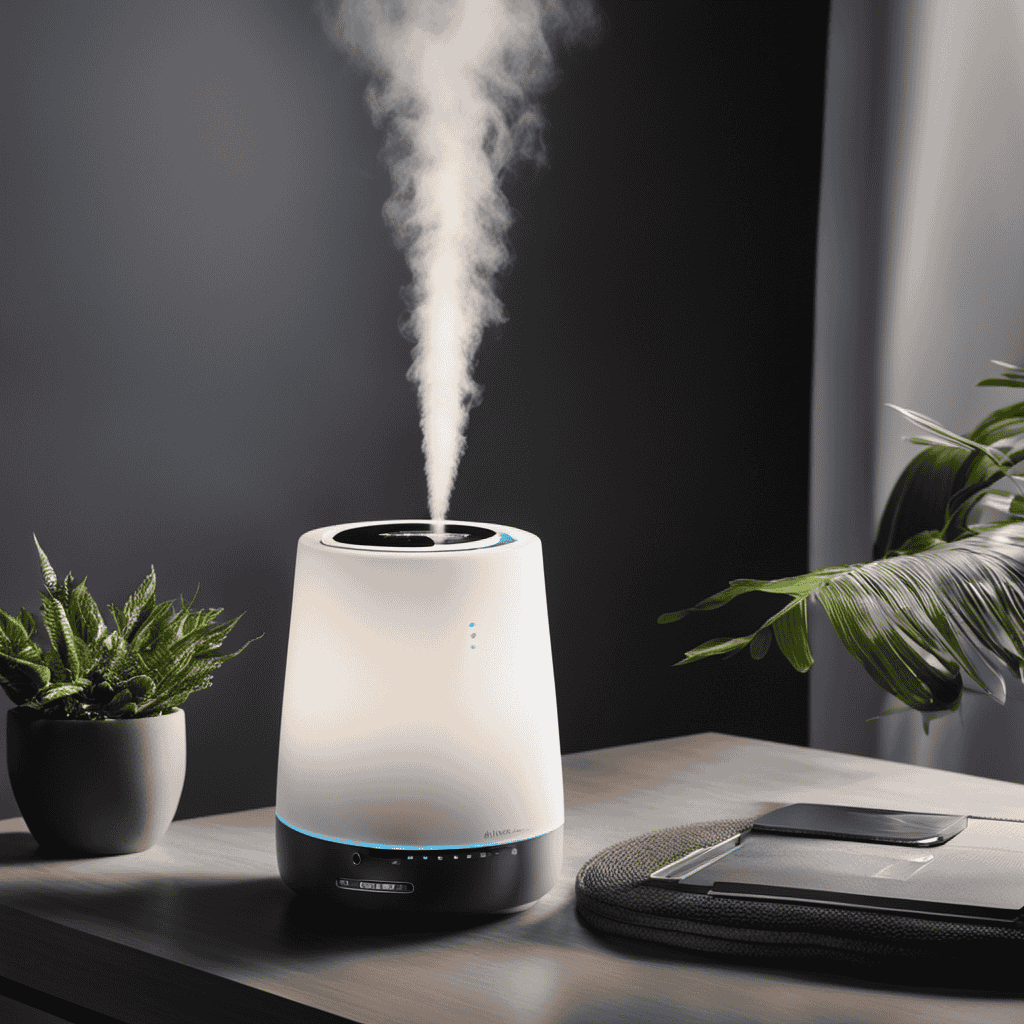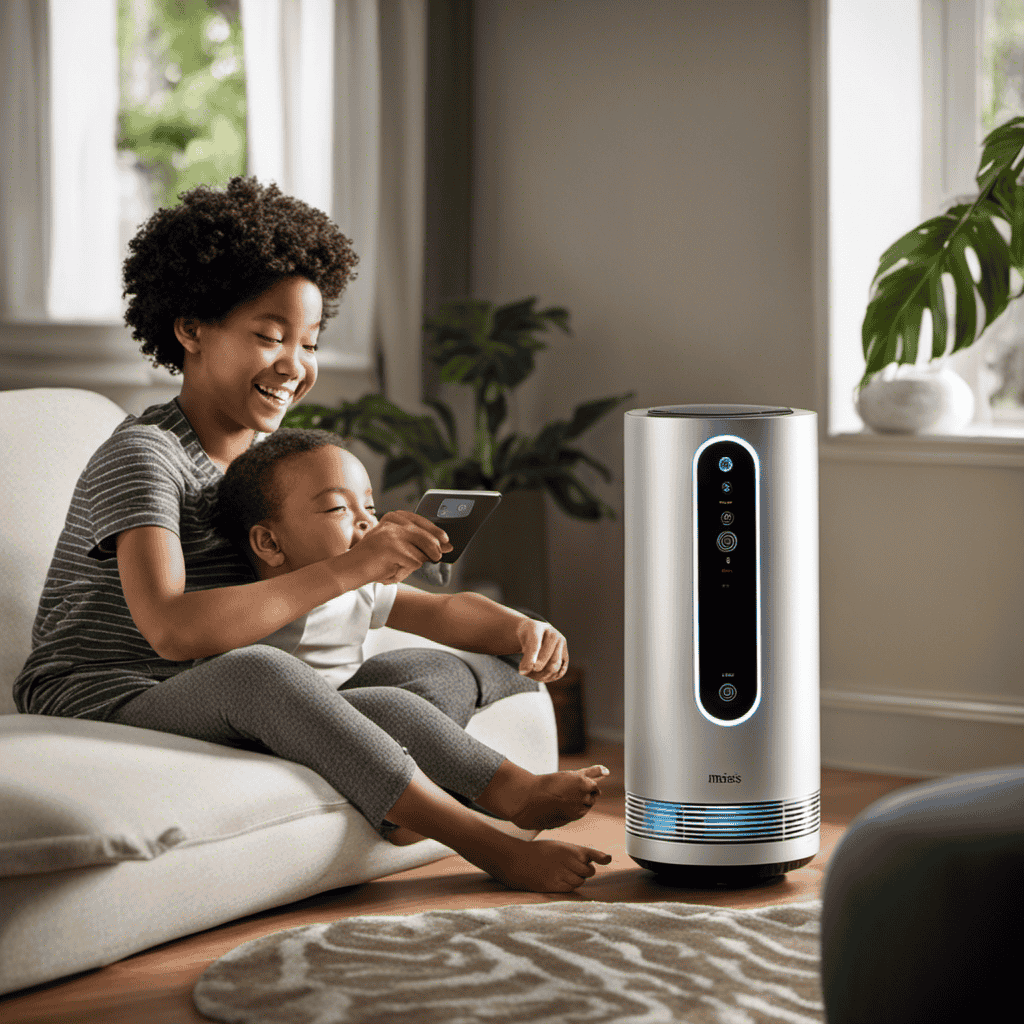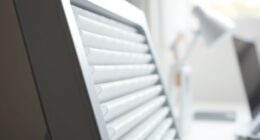I have to say, cleaning a Levoit air purifier filter is a total game changer. Believe me, once you notice the difference it makes in the air quality of your home, you won’t want to go back.
In this article, I’ll walk you through the step-by-step process of removing and cleaning your filter, ensuring that you’re equipped with all the necessary knowledge and techniques to keep your air purifier working at its best.
Let’s get started!
Key Takeaways
- Regular cleaning of the Levoit Air Purifier filter improves indoor air quality and promotes better respiratory health.
- Cleaning the filter removes dust, pollen, pet dander, and smoke particles, reducing allergy symptoms and respiratory issues.
- Cleaning the filter every 3 to 6 months, or more frequently in high usage or polluted environments, prolongs the lifespan of the filter and ensures its effectiveness.
- It is important to follow the manufacturer’s instructions, avoid using harsh chemicals or abrasive materials, and regularly clean the exterior of the air purifier to maintain a cleaner and healthier living environment.
Understanding the Importance of Cleaning Your Levoit Air Purifier Filter
Understanding the importance of cleaning your Levoit air purifier filter is crucial for maintaining its effectiveness and maximizing its performance. Regularly cleaning your air purifier filter offers numerous benefits, ensuring that the air you breathe is clean and free from pollutants.
When your Levoit air purifier filter is clean, it functions optimally, trapping and removing airborne particles such as dust, pollen, pet dander, and smoke. This not only improves the air quality in your home but also provides relief for those with allergies or respiratory conditions.
Regular cleaning also prolongs the lifespan of your air purifier filter. Over time, dust, pet hair, and other debris accumulate on the filter, causing it to become clogged. This reduces the filter’s effectiveness and puts strain on the purifier, potentially leading to decreased performance and even damage.
Step-By-Step Guide to Removing the Filter From Your Levoit Air Purifier
To start, you’ll want to locate the latch on your Levoit air purifier that secures the filter in place. Once you’ve found it, follow these steps to successfully remove the filter:
- Press the latch firmly to release it and unlock the filter compartment.
- Gently pull the filter compartment outwards to expose the filter.
- Carefully grip the filter from both sides and pull it straight out of the compartment.
- Be cautious not to touch the dirty surface of the filter, as it may contain allergens and pollutants.
Now that you have successfully removed the filter, it’s time to clean it. Here are some cleaning techniques to ensure your filter stays in optimal condition:
- Use a soft brush or vacuum cleaner with a brush attachment to remove any visible dust or debris.
- If the filter is heavily soiled, you can rinse it under running water. However, make sure to consult the manufacturer’s instructions before doing so, as not all filters are washable.
- Allow the filter to air dry completely before reinserting it into the air purifier.
Gathering the Necessary Cleaning Supplies for Your Levoit Air Purifier Filter
Once you’ve gathered all the necessary cleaning supplies, it’s important to follow the proper techniques to ensure your filter stays in optimal condition. Cleaning techniques for your Levoit air purifier filter are crucial in maintaining its efficiency and prolonging its lifespan. A regular cleaning schedule is recommended to prevent the buildup of dust, allergens, and other pollutants that can hinder the filter’s performance.
To clean your Levoit air purifier filter effectively, you will need a soft brush or vacuum cleaner with a brush attachment, mild soap or detergent, and clean water. Start by turning off and unplugging the air purifier. Carefully remove the filter from the unit according to the instructions provided in the user manual.
Next, use the soft brush or vacuum cleaner to gently remove any visible dust or debris from the filter. Be thorough but gentle to avoid damaging the delicate filter material. If necessary, you can also rinse the filter under running water, making sure to use only clean, cool water. Avoid using hot water or harsh chemicals as they can damage the filter.
After cleaning, allow the filter to air dry completely before reinstalling it into the air purifier. This ensures that no moisture is trapped inside, which can lead to mold or bacterial growth. Once the filter is dry, follow the instructions in the subsequent section to prepare it for cleaning.
Preparing the Filter for Cleaning – What You Should Know
Before cleaning, make sure you are familiar with the proper steps for preparing the filter. This will ensure that the cleaning process is efficient and effective. Here are the key points to consider:
-
Cleaning Frequency:
-
The frequency of cleaning your Levoit air purifier filter depends on the air quality in your environment. It’s recommended to clean the filter every 3-6 months for optimal performance.
-
If you live in an area with high pollution or if you have pets, you may need to clean the filter more frequently, such as every 2-3 months.
-
Recommended Cleaning Products:
-
To prepare the filter, you’ll need a vacuum cleaner with a brush attachment to remove loose debris and dust.
-
It’s also recommended to have a mild detergent or dish soap and warm water solution for thorough cleaning.
-
Additionally, a soft brush or cloth can be used to gently scrub the filter and remove any stubborn dirt or stains.
Now that you’re familiar with the cleaning frequency and recommended cleaning products, you’re ready to move on to the next step: cleaning the Levoit air purifier filter. In the following section, I’ll guide you through the best practices and techniques to ensure a thorough cleaning process.
Cleaning the Levoit Air Purifier Filter – Best Practices and Techniques
Now that you know the recommended cleaning products and frequency, let’s explore the best practices and techniques for efficiently cleaning your Levoit air purifier filter.
To ensure optimal performance and longevity of your Levoit air purifier, it is crucial to clean the filter regularly using the best cleaning products and adhere to a proper cleaning schedule. The first step is to turn off and unplug the air purifier before starting the cleaning process.
For cleaning the pre-filter, gently vacuum the surface to remove any visible dirt and debris. If there are stubborn stains or odors, you can use a mild detergent mixed with water to gently scrub the pre-filter. Rinse it thoroughly and let it air dry completely before reinserting.
When it comes to cleaning the HEPA filter, it is essential to follow the manufacturer’s instructions. Some filters are washable, while others may require replacement. If your Levoit air purifier has a washable HEPA filter, carefully remove it and rinse it under running water. Allow it to dry completely before reinstalling.
Remember to clean the air purifier’s exterior regularly using a soft, damp cloth and mild detergent. Avoid using harsh chemicals or abrasive cleaners as they can damage the unit.
Drying the Filter Properly to Ensure Maximum Performance
To ensure maximum performance, it’s important to completely dry the filter before reinserting it. Properly drying the filter is an essential step in air purifier maintenance to maintain its efficiency and prolong its lifespan. Here are some tips to help you dry your air purifier filter effectively:
- Remove the filter from the air purifier and gently shake off any loose debris or dust.
- Place the filter in a well-ventilated area where it can air dry naturally. Avoid exposing it to direct sunlight or excessive heat, as this can damage the filter material.
- If you’re in a hurry, you can use a fan or a hairdryer on a cool setting to speed up the drying process. Ensure that the air flow is gentle and not too hot to prevent any damage to the filter.
- Monitor the filter closely and make sure it is completely dry before reinserting it into the air purifier. Any moisture left in the filter can lead to mold or bacterial growth, reducing its effectiveness.
Properly drying the filter is crucial for maintaining the performance and longevity of your air purifier. By following these tips, you can ensure that your air purifier continues to provide you with clean and fresh air.
Tips for Maintaining a Clean Levoit Air Purifier Filter
If you want to maintain optimal performance, it’s important to regularly check and replace your air purifier’s filter. To prevent filter clogs and ensure that your Levoit air purifier works efficiently, follow these tips for maintaining a clean filter.
First, inspect the filter regularly for any signs of clogs or dirt buildup. If you notice any stubborn stains on the filter, gently remove them using a soft brush or cloth. Be careful not to damage the filter during this process.
Next, it’s important to clean the filter regularly. Start by turning off the air purifier and unplugging it from the power source. Carefully remove the filter from the unit and shake off any loose debris. You can then rinse the filter with water or use a vacuum cleaner with a brush attachment to remove any remaining dust or dirt.
After cleaning, allow the filter to completely dry before reinstalling it. This will help prevent any moisture-related issues and maintain the filter’s effectiveness.
By regularly cleaning and maintaining your Levoit air purifier filter, you can ensure that it continues to provide clean and fresh air in your space.
In the next section, we will discuss how often you should clean your Levoit air purifier filter to maintain its performance.
How Often Should You Clean Your Levoit Air Purifier Filter
Regularly checking and replacing your air purifier’s filter is important for maintaining optimal performance. The cleaning frequency of your Levoit air purifier filter depends on various factors, such as the environment it is used in and the air quality. However, there are some signs that indicate a dirty filter and the need for cleaning or replacement:
-
Decreased Air Flow: If you notice a decrease in the airflow from your air purifier, it could be a sign that the filter is clogged and needs cleaning.
-
Accumulation of Dust: A dirty filter will have a visible accumulation of dust and debris. If you see a layer of dirt on the surface of the filter, it’s time to clean or replace it.
-
Unpleasant Odors: If your air purifier starts emitting unpleasant odors, it could be due to a dirty filter. Cleaning or replacing the filter can help eliminate these odors and improve air quality.
To determine the ideal cleaning frequency for your Levoit air purifier filter, refer to the manufacturer’s instructions. Generally, it is recommended to clean the filter every 3-6 months, depending on usage and air quality. However, if you live in a highly polluted area or have pets, more frequent cleaning may be necessary.
Regular maintenance of your air purifier filter ensures that it continues to effectively remove airborne pollutants and provide you with clean, fresh air.
Common Mistakes to Avoid When Cleaning Your Levoit Air Purifier Filter
When cleaning, make sure to avoid these common mistakes with your Levoit air purifier filter.
Proper maintenance is essential for avoiding damage and prolonging the lifespan of your filter.
Firstly, do not use any harsh cleaning agents or solvents on the filter. These can cause the filter material to deteriorate and become less effective at capturing pollutants. Stick to using mild dish soap and water for cleaning.
Secondly, avoid using excessive force when cleaning the filter. Gently rinse it under running water and lightly pat it dry with a soft cloth or paper towel. Applying too much pressure can damage the delicate filter fibers.
Additionally, do not neglect cleaning the pre-filter. This is the first line of defense for your air purifier and can get clogged with larger particles. Regularly vacuum or rinse the pre-filter to maintain its efficiency.
Lastly, make sure the filter is completely dry before reinstalling it. A damp filter can lead to mold growth and impair the performance of your air purifier.
Troubleshooting Guide for Cleaning Issues With Your Levoit Air Purifier Filter
To troubleshoot cleaning issues with your Levoit air purifier, try checking the power source and ensuring that the filter is properly installed. Here are some troubleshooting techniques to help you resolve common cleaning mistakes:
-
Check the Power Source: Make sure the air purifier is plugged in and receiving power. If it’s not turning on, try plugging it into a different outlet or using a different power cord.
-
Inspect the Filter: Ensure that the filter is properly installed and seated in its designated place. It should fit snugly without any gaps or loose parts. If the filter is not installed correctly, it may not function properly or cause cleaning issues.
-
Clean the Filter: If you’re experiencing cleaning issues, it’s possible that the filter is clogged or dirty. Remove the filter and gently clean it using a soft brush or vacuum cleaner. Avoid using water or harsh chemicals, as they may damage the filter.
Extending the Lifespan of Your Levoit Air Purifier Filter – Expert Advice and Tips
As an expert on Levoit air purifier filters, I would like to discuss proper maintenance techniques and effective cleaning methods to help extend the lifespan of your filter.
It’s crucial to follow these techniques to ensure optimal performance and air purification efficiency.
Proper Maintenance Techniques
You should regularly clean your Levoit air purifier filter to ensure proper maintenance. Cleaning your filter not only helps to maintain its efficiency but also prevents mold growth. Here are some key techniques for proper maintenance:
-
Vacuuming: Use a vacuum cleaner to remove the dust and debris from the surface of the filter. This helps to improve the airflow and maintain the filter’s effectiveness.
-
Washing: If your filter is washable, gently rinse it with water to remove trapped particles. Make sure to dry it thoroughly before reinstalling to prevent mold growth.
-
Replacement: If your filter is not washable, it’s important to replace it regularly as recommended by the manufacturer. This ensures optimal performance and prevents the buildup of pollutants.
Regularly cleaning your Levoit air purifier filter is essential for maintaining its efficiency and preventing mold growth. In the following section, we will explore effective cleaning methods to help you keep your filter in top condition.
Effective Cleaning Methods
Regular maintenance is crucial for keeping your air purifier running efficiently and effectively. When it comes to cleaning your Levoit air purifier filter, there are specific methods you should follow for optimal results.
The cleaning frequency will depend on the level of pollutants in your environment, but a general guideline is to clean the filter every three to six months.
To clean the filter, first, turn off the air purifier and unplug it from the power source. Carefully remove the filter and gently tap or vacuum it to remove any loose debris. For a deeper clean, you can use a soft brush or a damp cloth with mild soap and water. Avoid using harsh chemicals or abrasive materials as they may damage the filter.
Once cleaned, make sure the filter is completely dry before reinstalling it into the air purifier.
Following these steps and using the recommended cleaning products will help maintain the efficiency and longevity of your Levoit air purifier.
Frequently Asked Questions
Can I Clean My Levoit Air Purifier Filter With Just Water, or Do I Need to Use a Specific Cleaning Solution?
I can clean my Levoit air purifier filter with just water, but it’s recommended to use a specific cleaning solution for better results.
There are different cleaning methods for the Levoit air purifier filter. These include rinsing it under running water or soaking it in a mixture of water and cleaning solution.
The frequency of cleaning depends on factors like air quality and usage. However, it’s generally recommended to clean the filter every 3-6 months for optimal performance.
Is It Safe to Use a Vacuum Cleaner to Clean My Levoit Air Purifier Filter?
Using a vacuum cleaner to clean my Levoit air purifier filter may not be safe. It could potentially damage the delicate filter material or dislodge particles back into the air.
It’s best to follow the manufacturer’s instructions for cleaning the filter. Alternatively, you can try using a soft brush or gently rinsing the filter with water. Just make sure to let it fully dry before reinserting it into the purifier.
Can I Wash My Levoit Air Purifier Filter in the Dishwasher?
Washing a Levoit Air Purifier filter in the dishwasher may not be safe. The high heat and water pressure can damage the filter, reducing its effectiveness.
It is recommended to use alternative cleaning methods, such as gently vacuuming the filter or rinsing it with water.
Always refer to the manufacturer’s instructions for proper cleaning techniques to ensure the longevity and performance of your air purifier.
How Long Should I Let My Levoit Air Purifier Filter Dry Before Re-Installing It?
When it comes to properly drying a Levoit air purifier filter, there are a few important tips to keep in mind.
First, ensure that the filter is completely dry before re-installing it to avoid any potential damage.
It is recommended to let the filter air dry for at least 24 hours in a well-ventilated area.
This will help maintain the lifespan of the filter and ensure its optimal performance.
Will Cleaning My Levoit Air Purifier Filter Affect Its Warranty?
Cleaning my Levoit Air Purifier filter will not affect its performance or warranty. It is actually recommended to clean the filter regularly to maintain its efficiency.
To clean the filter, I can use alternative methods such as vacuuming or rinsing it with water. However, it is important to let the filter dry completely before reinstalling it to avoid any damage.
Following these steps will ensure that my Levoit Air Purifier continues to function optimally.
Are the Steps to Clean a Levoit Air Purifier Filter the Same as Cleaning a Regular Air Purifier Filter?
Yes, the steps to clean a Levoit air purifier filter are the same as cleaning a regular air purifier filter. Start by turning off the purifier and removing the filter. Use a vacuum to gently clean off any debris, then wash the filter with mild soap and water. Allow it to fully dry before reinstalling.
Conclusion
In conclusion, cleaning your Levoit Air Purifier filter is a crucial maintenance task that should not be overlooked. By regularly cleaning the filter, you can ensure the optimal performance and longevity of your air purifier.
Following the step-by-step guide and best practices mentioned in this article will help you achieve a thorough cleaning. Remember, a clean filter means cleaner air for you and your loved ones.
Don’t wait, start cleaning your Levoit Air Purifier filter today and experience the true benefits of fresh and purified air.










